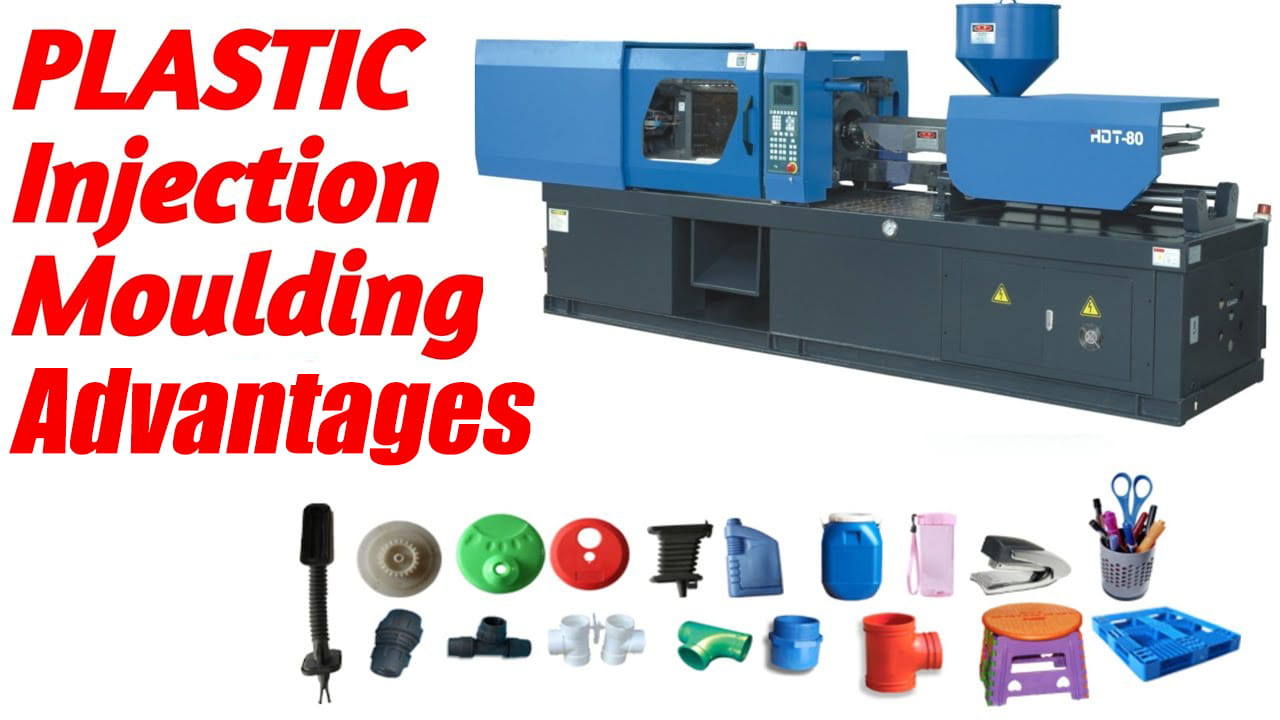Литье пластмасс под давлением стало одним из самых распространенных производственных процессов в различных отраслях промышленности. И не зря. Эта универсальная технология предлагает множество преимущества которые могут дать вашему бизнесу серьезное конкурентное преимущество.
В этом исчерпывающем руководстве вы, как профессионал производитель литья пластмасс под давлениемЯ проведу вас по ключу. преимущества литья пластмасс под давлением чтобы вы могли определить, подходит ли он для ваших производственных нужд.

Каковы преимущества литья пластмасс под давлением?
Возможности крупносерийного производства
Одним из самых больших преимуществ литья под давлением является его способность эффективно производить большие объемы пластиковых деталей.
Весь процесс в значительной степени автоматизирован с помощью машин и роботов. Разработав и изготовив пресс-форму для литья под давлением, вы сможете быстро производить тысячи одинаковых пластиковых деталей.
На самом деле время цикла формования может составлять всего 10-15 секунд. Это позволяет изготавливать сотни изделий в час в зависимости от размера и сложности детали.
Такая высокая скорость производства делает литье под давлением чрезвычайно экономически эффективным. Чем больше деталей вы производите, тем ниже стоимость единицы продукции.
Поэтому, если вам нужно создать большое количество пластиковых деталей - речь идет о тысячах или миллионах, - литье под давлением - это то, что вам нужно. Благодаря высокой производительности общие производственные затраты остаются низкими, а цены на продукцию - конкурентоспособными.
Допуски для сложных геометрий
Еще одним важным преимуществом литья под давлением является его допуск для производства сложных пластиковых деталей.
Расплавленный пластик впрыскивается в полость формы под очень высоким давлением. Это позволяет пластику принимать форму даже самых сложных геометрических форм.
В результате вы можете точно и многократно изготавливать пластиковые детали со сложными контурами, детализированными элементами и жесткими допусками.
К ним относятся детали с ребрами, бобышками, резьбовыми отверстиями, пазами, гравировкой, логотипами и т.д.
Способность создавать сложные компоненты литья под давлением открывает широкие возможности в плане дизайна и функциональности изделий.
Гибкость материалов и цветов
Когда речь идет о литье пластмассы под давлением, у вас есть, казалось бы, безграничные возможности в плане выбора материалов и цветов.
Существуют тысячи видов пластика, включая такие распространенные смолы, как ABS, полипропилен (PP), полиэтилен (PE), нейлон и другие. Все они обладают различными свойствами в плане прочности, гибкости, ударопрочности и так далее.
Вы можете использовать даже такие специализированные материалы, как медицинский, антистатический и инженерный пластик, для более сложных задач.
Такая гибкость материала позволяет точно подобрать механические и физические свойства, которые требуются в вашем случае.
Что касается цветов, то в вашем распоряжении миллионы оттенков и тонов. Литейщики под давлением могут изготовить на заказ пластиковые детали практически любого цвета, который только можно себе представить.
Распространенные методы окрашивания включают в себя использование предварительно окрашенных смол, цветовых матриц, жидких красителей или даже смешивание нескольких материалов вместе.
Усиленные прочностные характеристики
Современные передовые пластиковые материалы предлагают исключительные прочность Во многих областях применения они сравнимы с металлом.
В распоряжении литейщиков тысячи рецептур пластмасс со свойствами, соответствующими требованиям к прочности детали.
Среди вариантов - ударопрочные и ударостойкие материалы, а также пластики, армированные стекловолокном или углеродными волокнами для придания конструкции дополнительной жесткости. Эти усиленные пластики в некоторых случаях могут повторять прочность литых металлов или даже превосходить ее.
Существуют даже современные пластиковые композиты, сочетающие полимеры, керамику, наноматериалы, вспениватели и другие добавки, обеспечивающие превосходные механические характеристики.
Поэтому при правильном проектировании компоненты из литьевого пластика могут быть исключительно прочными и долговечными, оставаясь при этом легкими.
Снижение производственных затрат
Как уже упоминалось, литье под давлением отличается высокой эффективностью при производстве больших объемов пластиковых деталей, что неизбежно ведет к снижению производственных затрат.
Но помимо эффективности, это автоматизированный, упорядоченный процесс, который требует меньше прямых трудозатрат по сравнению с другими технологиями, такими как обработка с ЧПУ или 3D-печать.
После того как пресс-формы для литья под давлением разработаны, роботы и машины выполняют большую часть работы по производству пресс-форм. Человеческий контроль минимален.
Снижение трудозатрат напрямую ведет к сокращению производственных расходов. А эта экономия может быть передана заказчикам.
Кроме того, поскольку при литье под давлением образуется очень мало отходов материала, вы экономите ресурсы и сводите к минимуму расходы на вывоз отходов, которые включаются в ваши накладные расходы.
Быстрые сроки выполнения заказа
Первоначальный этап проектирования и изготовления оснастки для литья под давлением занимает некоторое время. Сначала необходимо создать прототип и провести испытания, прежде чем будет завершена разработка инструмента для литья.
Однако после создания и отладки пресс-формы время изготовления компонентов становится очень быстрым.
Речь идет о времени цикла до 10-15 секунд. С помощью многогнездных пресс-форм вы можете производить сотни пластиковых деталей в час.
Поэтому, если у вас уже есть существующие пресс-формы, литье под давлением позволяет очень быстро наращивать запасы для удовлетворения резких скачков спроса. Или быстро получить дополнительные пластиковые детали при необходимости.
Высокая пропускная способность позволяет поддерживать высокие производственные показатели и постоянную доступность продукции, несмотря на сжатые сроки выполнения работ.
Точная повторяемость
Последовательность и точность - отличительные черты процесса литья под давлением. Если все сделано правильно, вы можете производить чрезвычайно однородные пластиковые компоненты партия за партией.
Это объясняется тем, что при литье под давлением для изготовления каждой детали многократно используется одна и та же пресс-форма. Это обеспечивает очень высокую степень повторяемости и точности, не сравнимую с другими методами производства пластмасс.
В зависимости от размера детали, ее геометрии и используемого материала вы можете легко добиться допусков на пластиковые детали в пределах +/- 0,005 дюйма. Для сложных деталей такой уровень соответствия очень важен.
Экологически чистый
Наконец, литье пластмасс под давлением - один из самых экологически чистых процессов производства пластиковых деталей. При нем образуется очень мало избыточных пластиковых отходов по сравнению с традиционными производственными процессами.
Все лишние пластиковые литники или бегунки, оставшиеся после процесса литья под давлением, перерабатываются и повторно используются в будущих сериях. Это позволяет свести к минимуму потребление новых ресурсов.
Компании, занимающиеся литьем под давлением, также используют энергосберегающее оборудование и технологии автоматизации, чтобы сократить потребление электроэнергии и выбросы углекислого газа.
Многие из них также используют солнечную энергию или другие возобновляемые источники энергии для питания своих объектов. Это способствует уменьшению воздействия на окружающую среду.
В кратком изложении
Литье под давлением обеспечивает повышенную эффективность, снижение производственных затрат, быструю оборачиваемость, исключительную повторяемость и согласованность, устойчивость к сложностям, прочность и экологичность. Используя эти основные преимущества позволяет всем видам бизнеса улучшить работу и увеличить прибыль в долгосрочной перспективе.
